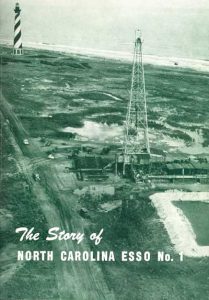
With the Gulf of Mexico oil spill still very much on our minds, we thought it timely to share with you a few items from our collections about oil drilling in the Tar Heel State.
Here are a few facts garnered from the various items. From 1925 to 1976, oil explorers drilled 120 wells in search of black gold. Their quest took them to 23 counties. The first exploratory oil well in the state was drilled near Havelock, in Craven County, in August 1925. Great Lakes Drilling Company probed to 2,404 feet. Most of the exploration was along the coast, but in 1974 Chevron drilled 5,348 feet in search of oil in Lee County. The deepest well in North Carolina was drilled within sight of the Cape Hatteras lighthouse in Dare County. Standard Oil of New Jersey, a precursor of today’s ExxonMobil, drilled 10,044 feet, but found no oil. In fact, none of the exploratory wells drilled between 1925 and 1976 resulted in oil production.
More recently oil exploration has focused mostly on deepwater drilling in the Outer Continental Shelf, federally-regulated waters off the U.S. coast. As relates to North Carolina, oil companies are interested in an area known as the Manteo Unit, about 40 miles off of Cape Hatteras. In the 1980s and 1990s, Mobil and Chevron sought to drill exploratory wells in this area. But their efforts were slowed and eventually halted by court and federal government action. A federal moratorium on offshore drilling expired in 2008 and with its expiration there was renewed interest in drilling off the North Carolina coast. Currently there are no leases for drilling. But the potential for drilling prompted state legislators to create an advisory subcommittee to study the issues related to oil exploration. That subcommittee released its report a week before the explosion of the Deepwater Horizon in the Gulf of Mexico.
And here are some of the resources available from the North Carolina Collection.
Map of exploratory oil wells of North Carolina, 1925-1976 . Note Well #1 in Dare County is the 10,044 foot well. Well #1 in Craven County is the first well dug in N.C. And Well #1 in Lee County is the western-most exploratory drilling.
James C. Coffey’s Exploratory Oil Wells of North Carolina, 1925-1976 provides a background and detailed key to the map.
The drilling of the state’s first well in Havelock is discussed in a 1927 publication from the N.C. Department of Conservation and Development.
Standard Oil published The Story of North Carolina Esso No. 1, an account of the drilling of the 10,044-foot well in Dare County.
Even prior to the drilling at Havelock, the Carolina Petroleum Company was trying to interest investors in oil exploration on the N.C. coast.
Possible oil among the coal shale in the Deep River Valley prompted Frank C. Vilbrandt to pen this report in 1927.
Mobil’s Initial plan of Operation Atlantic: offshore North Carolina: Manteo Area Block 467 details the oil company’s plans for drilling in the Offshore Continental Shelf in the late 1980s.
Atlantic outer continental shelf: final environmental report on proposed exploratory drilling offshore North Carolina includes the federal Minerals Management Service’s views on the potential impact of drilling on the North Carolina coast. The draft and preliminary final reports are also available.
